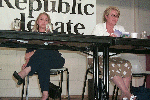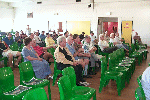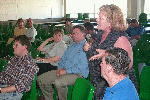 10th October 1999 - Commentary
by Scott Balson (left)
10th October 1999 - Commentary
by Scott Balson (left)
 10th October 1999 - Commentary
by Scott Balson (left)
10th October 1999 - Commentary
by Scott Balson (left)
 It
was a beautiful spring day. I was collected from my Karana Downs home by
Heather and Ken Hill who drove me into Ipswich.
It
was a beautiful spring day. I was collected from my Karana Downs home by
Heather and Ken Hill who drove me into Ipswich.
The Ipswich Workers Club is in an old, somewhat dilapidated building near the city centre and opposite the Ipswich railway station. The hall in which the debate was to take place was large and airy - covered with hundreds of bright green plastic chairs facing a large raised podium on which the speakers would debate the Republic.
Those involved in the debate included Senator Len Harris (No); Cheryl Kernot - Labor MP for Dixon (Yes); Ipswich Cr Paul Tully (No for this model) and Mary Kelly - University of Queensland equal opportunity officer (Yes and more)
(Tully was the individual who I caught with the now infamous "Bitch from Ipswich" pic - during coverage of the launch of One Nation on the Gold Coast in 1997)
Before the debate started I was able to take these informal pictures of the participants. (Will One Nation take Kernot next - if she wanted another move? Apparently the answer from Pauline Hanson is a firm "NO"!)... suggested title for image of Kernot smiling at camera second from left "Don't know who this guy taking the pic is but what a photo-opportunity!" (Read: he could be with Packer or Murdoch!)
 The
editor of The Australian, Campbell Reid, (right) introduced the speakers
and told the, less than 100 audience, that the debate would be held in a
set format. Cheryl Kernot would give the "Yes" case followed by Senator Harris
with the "No" case. They would then ask each other one question with questions
then following from the floor. A tea break would follow then Mary Kelly would
give her view followed by Cr Paul Tully with the question format as with
the earlier session.
The
editor of The Australian, Campbell Reid, (right) introduced the speakers
and told the, less than 100 audience, that the debate would be held in a
set format. Cheryl Kernot would give the "Yes" case followed by Senator Harris
with the "No" case. They would then ask each other one question with questions
then following from the floor. A tea break would follow then Mary Kelly would
give her view followed by Cr Paul Tully with the question format as with
the earlier session.
Reid mentioned that The Australian's editorial view was that the Republic should go ahead - he was, of course, parroting the view of his lord and master Lachlan Murdoch.
Cheryl Kernot's speech:
Cheryl Kernot spoke in glowing terms about the Republic while not giving details or supporting her feel-good comments with any facts. She was floored on a number of occasions by Harris when he asked her to comment on certain points in the proposed changes to the Constitution - asking at one stage for him to explain what it was all about.
 By the end of the session she looked less than happy and
presented the image of someone who did not really want to be there.
By the end of the session she looked less than happy and
presented the image of someone who did not really want to be there.
During the debate someone asked her about her views on the Labor party - she gave a cryptic response saying that she could not speak but was gathering "incidents" for a yet to be published "book" - which I would suggest implies that the Labor party should view their star recruit with some concern.
Kernot said that the Republic model would present no risk to our Parliamentary or Democratic process.
She said that the process was accountable and open - claiming that the current system is not accountable.
She said that the people should trust the politicians to behave systematically in moving Australia towards a "democracy".
"All we are doing is putting in an Australian head of state. Creating a President creates a different dynamic."
 In
supporting the model in which the Parliament select the President she said
that it would cost a lot of money to run as a national candidate. Only the
major parties could afford it so you would more than likely get an ex-politician
as President if that was the option going before the people. Sir William
Dean, for example would not put his name up if the people selected the president
- he would make an excellent President, she claimed.
In
supporting the model in which the Parliament select the President she said
that it would cost a lot of money to run as a national candidate. Only the
major parties could afford it so you would more than likely get an ex-politician
as President if that was the option going before the people. Sir William
Dean, for example would not put his name up if the people selected the president
- he would make an excellent President, she claimed.
The Constitution is broken she said - we should not be afraid to challenge authority.
"What has been the British Monarchy's connection with this country in the last few years?" she asked.
The Queen is a remote and distant figure... at this stage there was interference over the mike and the editor of The Australian scurried around trying to get the problem fixed. Once fixed Kernot continued:
"The days of Colonial empires are gone. Australians no longer have unqualified affection for the Royal family. Embracing the "YES" vote is one of the most exciting ways to start the next century.
Senator Len Harris' speech:
Harris impressed the audience with his knowledge of the Constitution, the proposed changes and the impact that they would have. He was a willing, technical and eager participant in the debate.
 Harris
said that the changes will be written into the Constitution. The power will
be removed from the people (as it is now) and handed over to Canberra.
Harris
said that the changes will be written into the Constitution. The power will
be removed from the people (as it is now) and handed over to Canberra.
"What is more important is the rights of the people," Harris said.
The Republicans are going to change things that they are not willing to talk about, Harris claimed. In rebutting Kernot's comment about the 100 year old Constitution being out of date he referred to the American Constitution which is 200 years old and still as valid today as then.
He referred to the power of the High Court when it proclaimed Britain a foreign power during the Hill case.
"It is the role of the judiciary to administer, not interpret, the laws that
are developed by Parliament," he said. Why are we having this push for a
Republic he asked - the new Constitution officially recognises the role of
the Prime Minister and the opposition - something which the old Constitution
did not. Our politicians should be renamed representatives of the people...
The member who represents you in Ipswich should have the same rights as the
member for Bennelong (John
 Howard)
- and these powers should not be based on the whim of the party machine
- as they are now.
Howard)
- and these powers should not be based on the whim of the party machine
- as they are now.
With the politicians selecting a President the man will always be politicised through the role of the party machine.
Harris said that we don't know how our common law rights will be affected if we become a Republic.
He talked about freehold tenure over land claiming that both the government and opposition recognise that the only thing saving your land from native title claims is the tenure of the Crown. Noel Pearson is on the record as saying that. In other words if we become a Republic we remove the protection of the Crown and freehold land would be subject to native title claims.
 Nick
Minchin claimed that native title existed in 1788 - when Australia was colonised
- this would mean that native title would exist today over all land under
the Republic model.
Nick
Minchin claimed that native title existed in 1788 - when Australia was colonised
- this would mean that native title would exist today over all land under
the Republic model.
Harris said that the preamble was also dangerous and people should vote "NO" on that as well. It makes no reference to the states. It also recognises and honours Aboriginals as the first inhabitants of the land. The High Court will use the preamble, as it has in the past, to clarify a position. This reference to Aboriginals is extremely dangerous.
On sovereignty Harris said that in the UK it is an entity in the Parliament; in the USA it is the President and in Australia it is with the people.
The whole Republican process is to move the sovereign power from the people to Canberra.
Furthermore, Harris said, there has been no final Constitution developed - but we do know that it will have some 69 changes... imagine what the high Court will do with this!
He implored those present to vote "NO" for the Republic and the preamble.
Pics of the panel:
Kernot's question to Harris:
"Under our current system how do people today really have any power or representation in Parliament?"
Harris: Look at the process of the power where it lies at the present moment. The power in the Crown lies in its ability to remove those who misuse their power. This option will be removed under the Republic model being put to the people.
He then referred to a Bill which has already been passed in the Queensland State parliament by the Beattie government which will make this state a Republic if the people vote "YES".
"There will no longer be a Governor General in Queensland," Harris said.
Harris' question to Kernot:
 In
the Bill which you voted for there is a change to Section 126 of the
Constitution. Please explain what impact that change to the Constitution
will have on the people.
In
the Bill which you voted for there is a change to Section 126 of the
Constitution. Please explain what impact that change to the Constitution
will have on the people.
Kernot had no idea what Harris was talking about and quickly pulled out her copy of the Constitution. (Image right Kernot checks up on Section 126)
(The revised Section 126 passes sovereignty from the people to the Parliament).
Questions from the floor:
 Several
questions were asked from the floor - mostly aimed at Kernot and supporting
a "NO" vote.
Several
questions were asked from the floor - mostly aimed at Kernot and supporting
a "NO" vote.
 A
Mr Taylor asked how he could trust Kernot or politicians after her support
in the Coalition's changes to Industrial Relations as a Democrat had seen
massive anti-worker pro-big business changes being made.
A
Mr Taylor asked how he could trust Kernot or politicians after her support
in the Coalition's changes to Industrial Relations as a Democrat had seen
massive anti-worker pro-big business changes being made.
Image right Pauline Hanson looks on as a question
is asked. (Pauline stayed for a short
 while
- leaving after the tea break).
while
- leaving after the tea break).
Bill Ryan asked why the first preamble was changed and the wording "Equal sovereignty of all Australians" removed.
Len Harris replied that we had been asked to accept the Republican model without facts but through warm fuzzy words. He said that under the current system the Bill of Rights protected individuals.
Tea break:
I took these images during the tea break:
After the tea break Mary Kelly and Paul Tully spoke giving shorter speeches putting their views.
Mary Kelly's speech (points raised):
A truly democratic constitution:
ignores our multicultural character
looks at human rights
reform of the two houses of Parliament
make the more respected
a gender balance 52% F: 48% M
Bill of Rights for collective freedom
You cannot democralise a system by fiddling around the edges. My sovereign rights come to me as a citizen of this country not as a servant of the Queen.
We should not invest a lot of power in just one person... give the power to a group - we don't want to be like America.
I support an Irish style model where the President cannot dismiss a government and so on. I recommend that you vote "YES" and add "MORE" - to bring on further democratisation.
Paul Tully's speech (points raised):
The chances of this referendum succeeding are growing slimmer as people realise
that they do not have a vote on who the President will be.

On the final vote at the Constitutional Convention in February 1998 the Australian Republican Movement (ARM) only received 73 votes out of 150. Incredibly Howard declared this as "clearly preferred".
The Republican model as it stands now is half-baked.
Why not let the Australian people choose who they want as President?
I have visited the pubs and clubs of Ipswich - Labor heartland - and they are saying "we want to vote our own President in".
Tully believes that only two states will support the referendum so it will be defeated (all states have to agree).
The sovereign power of the people cannot be negotiated. The so-called bi-partisan model had no real changes to the ARM model which represents people like Kerry Packer.
"I predict that there will be a new Republic referendum based on people having the vote to elect the President," Tully said.
Kelly's question to Tully:
What do you base the suggestion that there will be a new referendum (if this one is defeated)?
Tully's response: What chances have your "YES and more" proposal of getting up if the politicians in Canberra have achieved what they wanted?
Tully's question to Kelly:
"Do you regret supporting the bi-partisan model?
Kelly's response: We sought options and we did not get them. We chose to vote with the ARM to kick the Queen out.
Question time followed.
During this period just before the close an interesting argument arose.
After a member of the audience asked a question the editor of The Australian exacerbated by all the "YES" support asked the lady if she was a member of One Nation.
Harris shot back, "The inference is that we are to nominate if a person from One Nation has asked the question."
The editor replied, "I'm sorry, I didn't mean that."
Section 126 was a key point raised by Harris - the transfer of sovereignty from the people to the Parliament. I think that and the native title/freehold land issue were killer punches that Kernot had no response for.
Even The Australian newspaper recognises that point in today's paper.
Below are some assorted images taken during the debate:
Kernot unhappy and distant for much of the second half; reporters listen to a question; a Republican listens to a Monarchist; Kelly and Kernot
Labor's unsuccessful changes to the Republic
model
Return to Australian
Daily Issues paper